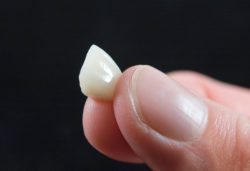 When we see a patient with a damaged tooth, or one that has developed a serious oral health issue, then treatment is crucial. Otherwise, complications can arise that threaten the health and comfort of the smile. Often, we suggest a restoration to fix a tooth, such as a filling or a crown. How does a restoration repair a tooth? What should you expect from the placement process?
When we see a patient with a damaged tooth, or one that has developed a serious oral health issue, then treatment is crucial. Otherwise, complications can arise that threaten the health and comfort of the smile. Often, we suggest a restoration to fix a tooth, such as a filling or a crown. How does a restoration repair a tooth? What should you expect from the placement process?
Dental Crowns
A dental crown fits over the entirety of the tooth’s visible portion. We create them using ceramic, a lifelike material that can be color-matched and withstand serious bite forces. With CEREC technology, we can create and place them in a single visit. We have used them to repair broken, chipped, or cracked teeth. We can also address teeth with cavities or infections. We’ve used them to reshape malformed teeth. Finally, they are an excellent way of aiding in tooth replacement, whether anchoring a dental bridge in place or completing a single tooth dental implant.
Dental Fillings
We primarily place fillings to repair decayed teeth. Once again, the restoration only takes a single visit to complete. We first remove any decay and then thoroughly clean the tooth. We color-match the metal-free composite resin and apply it in layers. We sculpt and shape the area as the tooth cures under a light. We polish the tooth for a more natural appearance. The tooth is then safeguarded against decay.
Inlays and Onlays
These are the halfway points between fillings and crowns, also known as partial crowns. Made from porcelain, these custom restorations either fit over the cusps (onlays) or between the cusps of the tooth (inlays), providing substantial restoration that targets a specific area of the tooth, allowing you to preserve more of your natural tooth structure.
